I’m more than a little interested in the “how you know” of paleontological reconstruction. As it may be apparent by now, I’m an artist, and as such tend to see things on an aesthetic level more than a technical one. Although I still see things technically, I look at them through aesthetic eyes. Because I’m a relativist, I try to put perspective on this by occasionally taking those glasses off, and look at something ONLY in a technical light, but this is hard: There are times when, regardless of the technical expertise of the work, I like its aesthetic, and this causes me to have issues on writing, where my tone and thoughts jumble together. It feels right, now you’re making me read it through like an editor?!
But art sometimes must take precedence, because in technical illustration, we have to be able to easily understand what we are seeing. A highly technical illustration is easy:
The above image was produced from multiple source skulls, primarily based on GIN 100/25 (the “Fighting Dinosaurs” specimen, which is somewhat crushed and eroded). It is presented here at top left lateral view, below that with the same perspective through sagittal section anterior to the lachrymal, in coronal section at the fourth maxillary tooth/fifth dentary position, in dorsal view, and in ventral view of the snout (upper rostrum and lower mandible). This is technical because having your proportions, measurements, and superficial details accurate is the point. It is generalized, and does not represent an actual specimen, but its close to virtually all of them. This is technical, but it’s still art, because I chose to stipple the skull, rather than pencil shade it, I chose a stylized method of depiction rather than just a photograph, I “faked” the lighting, etc. There are flaws, such as where the jaw is illustrated separately, so that shadows from the upper teeth do not fall on the lower jaw, and I decided not to add them in after the fact. I also had to “guess” at the medial view, based on description and what meager evidence there is from other, related taxa (I had to use the maxilla of Velociraptor osmolskae [IMM 99NM–BYM–3/3; Godefroit et al., 2008] and the snout and jaws of Dromaeosaurus albertensis [AMNH 5356, following Currie, 1995] and Deinonychus antirrhopus [YPM 5210 and YPM 5232, following Ostrom, 1969] as sources), and as such it becomes an approximation.
But the depiction of soft tissues is more difficult. It requires a substantial knowledge of technical details, photographic or on-hand material in the form of living or cadaverous specimens. Despite this, reconstructing this tissue for presentation is almost all art, and it goes doubly so for dinosaurs as they are extinct, and triply so because of the problem of the phylogenetic bracket:
When comparing dinosaurs as living creatures to their extant survivors (birds) and living remnants of their sister group crurotarsans, Crocodilia, dinosaurs exist in a grey area. On the one hand, they contain birds, which have scales only on their legs, and go otherwise feathered or naked skinned on the face, and always have a keratinous beak. Crocs, on the other hand (or face), have a squamous (scaly) integument all over the face, teeth, and absolutely no feathers. I won’t even try to draw that, artistic license or no.
However, recent dinosaur “documentaries” (Discovery Channel’s Dinosaur Revolution and BBC’s Planet Dinosaur) have pushed further on the dinosaur reconstruction angle, and I became prompted to remark on one peculiarity that struck me going all the way back to 1993, with the release of Universal’s Jurassic Park. As a kid barely into dinosaurs, I was massively stoked by this movie, but unlike many then and current budging artists, I had been inundated under the “real” dinosaur revolution of the 80s, wherein I learned about fluffy dinosaurs from Bob Bakker, reading frequently-signed out copies of Greg Paul’s Predatory Dinosaurs of the World, and the earlier controversy with John Ruben and Alan Feduccia among others countering the argument that not only were dinosaurs likely scaly beasts, they had nothing to do with bird evolution.
Because I happen to be a relativist and a cynic, my thoughts on these were “how do they know?” Then I started reading work by a guy named Larry Witmer, whose college and professional career has been to precisely answer that question. Having formulated the argument of the phylogenetic bracket, Witmer proceeded to them apply it to soft-tissue reconstruction, and has been steadily dismantling various hypotheses and building new ones from the remnants. This, I thought, is why I don’t stick to a single type of dinosaur reconstruction. It essentially led to me placing disclaimers, either in the description or in my own head, that everything I drew was based on the preconception of what I knew, and the best way to draw better was to know more.
Most certainly, the thing that strikes out most when it comes to dinosaur reconstruction is integument, because it is the first visually-striking thing next to posture. Below that, though, there are fleshy tissues, such as skin itself, fat, ligaments and muscle, and so forth.

Komodo dragon (Varanus komodoensis), borrowed from Zooillogix.
Consider above, the position of the nostrils. These are placed roughly at the lateral margins of the underlying bone, and extend somewhat to the limits of the rostral and lateral bony jaw. Everything beyond that is essentially soft tissue: ligament, muscle, skin, scale.
Now look at a dinosaur:

“Velociraptors.” Left, Velociraptor mongoliensis, from Greg Paul (1987, 1988). Middle, Mark McCreery’s “velociraptor” from Jurassic Park III (you can tell because the head has “feathers”). Last, Deinonychus from Dinosaur Revolution, rendered from Dave Krentz and by far the best digital reconstruction to date.
There are various things going on here that are complicated to explain simply, but notice that all of these reconstructions are nice and fluffy (well, the first and third are). Greg Paul’s reconstruction, favoring at times an upper lip, upper dentition that fit over the lower lips, and a rostral beak, is the most svelte: the animal represented was the size of a small dog, or turkey, but long-legged and tailed. Mark “Crash” McCreery’s designs for Jurassic Park have been largely preserved for the “velociraptors” in all three films, with the addition of “feathers” on the head in the third installment, but the head is very fleshy and reminds me of naught but a monitor lizard, with a broad U-shaped jaw that belies the slender, narrow tooth row you can see in this image (and why I chose it). Paleoartist Dave Krentz designed much of the dinosaur-y look for Dinosaur Revolution, and the extensive feathery covering shows. The facial reconstruction, however, borrows much from the look of McCreery’s “velociraptors,” down to the broad lips that covered the upper dentition, unlike as in Paul’s reconstruction.
The question, then, has been whether dinosaurs had lips. The tissues involved differ from group to group, as in mammals these are formed from large bundles of muscles that are anchored to the bone and skin around the oral cavity, and incorporate muscles linking the jugal (zygomatic arch) and mandible to form “cheeks,” while in reptiles they are lightly muscled and largely incorporate a large ligamentous band that wraps around the rostrum and connects to the skull at the jugal arch on either side of the upper jaw, and towards the coronoid in the lower jaw. In lizards and snakes, this band is large and distinct, and the muscles in snakes can be very numerous and the band very elastic. In crocs, however, this band is very thin, or may even be absent, but the fleshy tissues are still fairly broad:
The teeth here cross one another, passing one another to lie on the external margins of the jaw of both upper and lower jaws. In alligatorids, the lower dentition lie inside the upper, and connect to pits between upper teeth, so the lower dentition is generally not visible, but this is generally not the case in crocodilids, where the lowers pass the lateral margin of the upper jaw. A crocodilid is shown above.
If birds lack lips, and crocodilians have little or no lip, but the ancestors of both likely had them (an inference from lizards such as the monitor above), then how do we arrive at lips in dinosaurs?
The first clue, of course, is studying the analogues of “lips” in reptiles and mammals, and determining if they exist in dinosaurs. There is a line of foramina along the margins of the skull, known as nutrient foramina.
Typically, these are round and sit within small depressions that form channels along the bone surface toward the jaw rim, where exiting nerves, veins and arteries extend toward the gums that the teeth sit within. The mandible might have a deep channel linking several of these foramina in the posterior portion of the jaw, often connecting to the anterior surangular foramen at the dentary-surangular contact, while the upper jaw might have a shallow channel connecting to the jugal foramen, which is almost certainly pneumatic as it connects inside the bone to a large hollow diverticular “camara.”
These, as in reptiles, are linked also to the nerves and blood vessels that “feed” the labial soft-tissues (ligaments, muscles, skin) and are thus connected to the implications for “lips.” However, the constraint here with mammals ends. Mammals typically only have a few foramina connected to these tissues, maxillary, mental, and anterior and posterior mandibular foramina. As noted, mammalian facial muscles make the bulk of their lips, while reptiles are less muscly in the face. The extensive nutrient foramina then are linked to a different set of tissues, larger branchings of the facial nerves, and external nutriation of the teeth than in mammals (which are primarily fed from branches of the nerves and blood vessels within the jaw). More extensive gum tissue, surrounding the teeth, also characterize reptiles. This fact of gum tissue, a feature that McCreery and Krentz also adopt, ends up resulting in “small” teeth as apparent from outside the jaw:
(Despite the amount of flesh wrapped around these jaws, the rims of the antorbital fenestra and orbit are still plain to see, and this should certainly NOT be the case.)
McCreery manages to follow lizards in another aspect, that of characterizing large labial scales. Crocs have very small labial scales, and they are thin and broad but closely associated to the jaw margin, just as any ligamental tissue is reduced. Lizards and crocs, just as in some birds, have some additional facial features that mammals lack, such as the presence of electrosensory organs like dermal pressure organs or Herbst corpuscles. These require additional innervation. Were these likely present in dinosaurs? The answer to this is unknown, but the jaw anatomy at least points to dinosaurs like Velociraptor mongoliensis as having lizard-like facial tissues, in nature if not in exact form. Phylogenetically, however, they are close to birds, and this has caused some artists (notably, Greg Paul) to “thin down” the integument and bring the skin close to the bone surface. Lips are a passing fad in this case, except when needed. This can have comical effects on the appearance of the animal, as McCreery’s “velociraptors” may attest (and yes, I find them humorous to look at).
The reason I doubt the extensive tissues of film “raptors” is that the soft tissue of lizards generally follow the bony jaw margin, so that the rounder the bony rostrum in monitors, the rounder the fleshy rostrum; narrower, narrower. And Velociraptor mongoliensis has a very narrow rostrum:
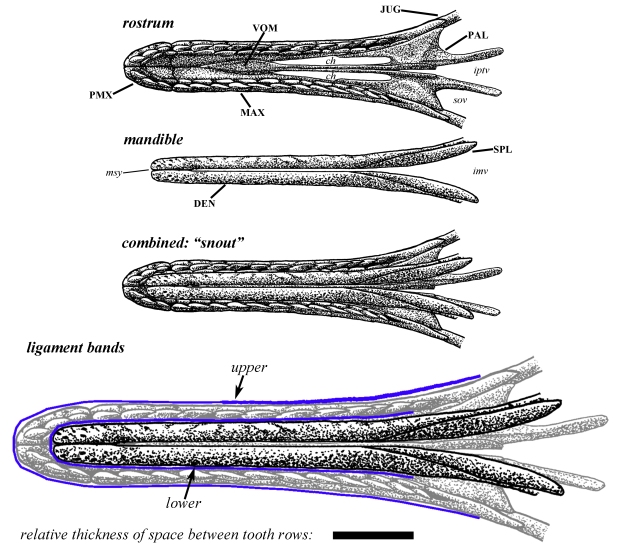
Snout of Velociraptor, showing the upper rostrum and mandible in ventral views, and then combined, and finally below with the “fitted” ligamental bands of the “lips.” The broad black bar indicates the room between upper and lower jaws.
Relative to the breadth across the orbits, the snout of Velociraptor is almost 1/3 as broad. This is ridiculously narrow in comparison to, say, Dromaeosaurus albertensis, a related taxon, in which the snout is more than half as broad and the mandibular halves broadly approach one another in a tight V. Moreso the mandibular halves, as they are essentially parallel for over half their length. Velociraptor mongoliensis lacks a broad rostrum, has a very narrow palate, and the palate is highly vaulted in the midsection of the snout, leaving little room for a narrower jaw to have extensive soft tissues. When one places the skin of an animal with a jaw twice as wide around this, to produce McCreery’s “monitor” look, it is rather comical, and there is no analogue for this.
Pretending here that I have any sort of credibility, I present the extremes of the discussion for lip tissues in the “monitor” style of McCreery at top, and at bottom in the “fleshless” style of Paul; between these is a moderate compromise of limited tissues and ligamental bands. Not clear in the image above is that in the bottom depiction, the mandibular ligament band is between the jaw and the teeth of the upper jaw, and this is almost certainly wrong as it compares to no living animal. It is my conclusion that if there is a fleshy lip from the lower jaw, it covered the upper dentition, concealing them. The alternative is that the lips of both jaws are short and retracted, exposing the margins of uppers and lowers equally.
As there is (as yet) no evidence of a fleshy-lipped bird (rather than a beak, and no, I’m not talking about toothy birds like Archaeopteryx or Xiaotingia — these birds should have “lizard-like” jaws even so) the conclusions on lip-ness must derived from anatomical analysis, and so far, this data has yet to be produced (yes, I’m hinting at work down the road, especially that of Witmer and Holliday and the like).
Above is my crack at conceptualizing the constraints on what we can infer from the tissues alone: The types of tissues and their arrangements in a lizard, croc and bird, as well as the (current) covered-lipped ‘raptor from Greg Paul, and the older version (termed “Dinosaur”). The cross-section is modeled from Velociraptor mongoliensis above, but is more stylistic. The ridge extending upward within the chamber marked “nasal passage” represents the vomer, which would support additional structures such as thin bone dividing the chamber in two vertically, and turbinate bones curling to the sides, and are not shown for simplicity. In all depictions, the jaw structure is shown identically, and where is seems interdental plates are present, know that the space dividing the bone represents lingual nutrient foramina innervating the base of the dental alveoli. In “Paulian ‘Raptor,” note that a bit of the orange (rhamphotheca) exists atop the snout, an allusion to Paul’s continuing hypothesis that dromaeosaurs (and Archaeopteryx) have rostral beaks.
Also note that this is art. While I may be somewhat scientifically informed, I am covering my inadequacy by being very limited and stylistic in depictions: a pure sciency presentation would show actual tissue sections alongside representations, and I lack the means of producing the former. Thus I am making my arty stuff very colorful. Forgive me. But because I am trying to be all sciency — and I’ve been doing this over the course of only two days — it is not the best art I can do, and if I wished to try hardest, I would likely produce vector versions for absolutely clean lines and the ability to retain sharp margins at any scale, but alas, not yet (also, I lack the software).
Back to the image. In a typical reptile (“Lizard”), the lips (tan) contact one another outside the dentition, and they are further concealed by labial scales (yellow). Ligaments (blue) are large and pull the facial tissues outwards. This increases in some flexible-snouted lizards, such as monitors, where the tissues are even broader. In a crocodilian, the ligaments are smaller, and the labial scales are thinner and curve along the tissues, supplanting and covering the gum tissue (red) alongside the teeth (black, along with bone). In a bird, gum tissue and facial skin are supplanted by rhamphotheca (orange, here not depicting the separate plates that are distinct in many taxa), and I’ve modified the jaw to coincide with modern birds lacking teeth.
The two “dinosaur” depictions consider the two most heavily used depictions for theropod lip structure. The first,”Dinosaur,” is the most common version, and this generally follows a desire to show the upper teeth. Generally, theropods are shown either having fleshy lips à la lizards, or with almost none (as in Rudolph Zallinger’s mural, The Age of Reptiles, at Yale’s Peabody Museum). I’ve shrunk the mandibular ligament to correspond to the tight fit (as seen in my Velociraptor snout above), and the lips are also fit in but had to be extremely slimmed to do so. Because depictions of the squamation of dinosaurs varies relative to how close to birds they might get, I’ve shown this form of ‘raptor without squamation, and thus omit the labial scales. I’ve left labial scales off of the second depiction of a dinosaur as well, the “Paulian ‘Raptor.” Here, however, the lips are passed outside of the teeth and are thicker.
The real question, then, is which one of these is closest to the true dinosaur? It may and very likely is relative to the group. It is my impression that there is absolutely no evidence for lower lips fitted between the jawbone and the upper teeth. This doesn’t mean that the lower lip was lateral to the upper teeth, as a condition present in long-toothed mammals likely precludes this in some theropods or ornithischians in which upper dentition extends below the jaw margin. This is due to an additional anatomical constraint, and is the second clue.
Remember Dilophosaurus wetherilli?
When closing the mandible, the upper teeth extend well below the mid-height of the jaw, meaning that any soft-tissues wrapping up and around the teeth to close the lips would have to extend deeply and below the jaw, a feature unknown in extant reptiles aside from various crocodilians, and in none that have lips that conceal the teeth. Is there something different going on? I also wondered about how sabre-toothed mammals deal with this issue. Canines (Canis lupus) and all cats have long canines: the lower canines slide into slots called diastemata between the upper incisors and the upper canines, and these diastemata are fairly large in cats but less so in dogs. The upper canines, however, extend well below the mid-high up the upper jaw in most felids, and in sabre-toothed cats, can be as long as the lower jaw itself. This is accommodated in these carnivorans by the lower lip being protruded below the teeth, but not covering them.

Cats both domestic and sabre-toothed. Thin lines depict the margin of the fleshy lower lip. Light grey on the right depists the exposed soft-tissue of the inner lower lip and gum.
Is it possible then, that dinosaurs could have had similar lips for elongated teeth, but shorter, “normal” lips for shorter teeth? Certainly, although I will not claim to assert these to be true. It may simply be that long-toothed dinosaurs had fleshier jaws in the style of monitors and McCreery’s “velociraptors,” just fleshier and deeper. And with something like Velociraptor, it may not be so easy to distinguish the two:
So back to Velociraptor mongoliensis. Depending on how closely one wishes to “fit” the jaws, one gets different levels of soft-tissue “room.” First, lizard-style, the teeth do not necessarily pass further than the bony margins of the opposing jaw, and this depends on how tightly left and right halves were. Very tight, and we might get the “lightly closed” perspective, with virtually no room to go further. But I suspect the jaws were capable of further closure, and can close the jaws at least as far as the upper dentition coming to the nutrient foramina of the lower jaw (middle). Here, the teeth come close to palatal surface of the maxilla and premaxilla, but barely. And lastly, if the jaws are broad enough, the teeth press all the way to the palate, and the jaw is positioned as it has been preserved in several specimens. I wonder if that is rather based on distortion, but if not, it implies the “croc” style jaws shown above (and inset in the image). This would leave little room otherwise to the sides of the lower jaw (shown in coronal section at right) for lips, and we might get a broader, yet less fleshy head. The upper teeth would protrude almost past the gular (ventral) margin of the jaw, and this might imply a “cat-like” lower lip.
Which one, which one?
In the end, I am not satisfied with any of these ideas. This is because I do not think we have all the details at hand in order to correctly depict these lips. Until then, i tend to favor the model of existing reptiles and place lips around the dentition, as I described a few posts earlier:
As an aside, but no less important, it should be noted that I absolutely disagree with the mere hypothesis that any sort of remnant of a beak exists in toothed “velociraptors,” sensu Greg Paul. There is quite literally no reason aside from speculation that even early birds like Archaeopteryx had beaks, and no reason to think, even if Paul’s “neoflightlessness” hypothesis is correct, to presume that larger-bodied, larger- and many-toothed theropod dinosaurs would have had them. This is especially significant given the similarity in snout anatomy to fleshy-jawed reptiles, the rounded margins of the bone, and the absence of any argument for an analogue to a rhamphotheca aside from “numerous foramina” or “rough texture” (both of which exist in squamous, non-beaked reptile jaws). I will actually return to this concept where, showing data outlined here, I demonstrate the artistic inconsistency in which even Greg Paul has attempted to demonstrate this idea.
Currie, P. J. 1995. New information on the anatomy and relationships of Dromaeosaurus albertensis (Dinosauria: Theropoda). Journal of Vertebrate Paleontology 15(3):576-591.
Godefroit, P., Currie, P. J., Hong L., Yong S.-c. & Dong Z.-m. 2008. A new species of Velociraptor (Dinosauria: Dromaeosauridae) from the Upper Cretaceous of northern China. Journal of Vertebrate Paleontology 28(2):432–438.
Osborn, H. F. 1924. Three new Theropoda, Protoceratops Zone, central Mongolia. American Museum Novitates 144:1–12.
Ostrom, J. H. 1969. Osteology of Deinonychus antirrhopus, an unusual theropod from the Lower Cretaceous of Montana. Bulletin of the Peabody Museum of Natural History 30:1-165.



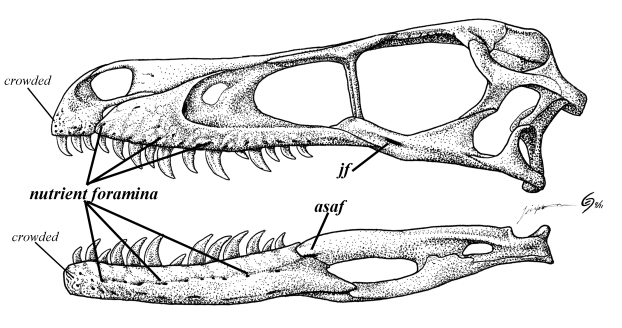

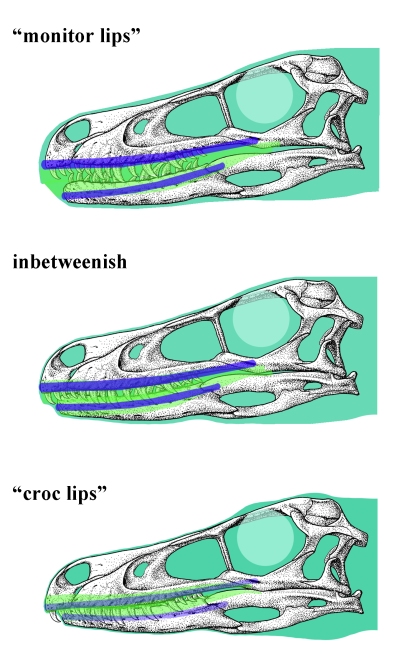
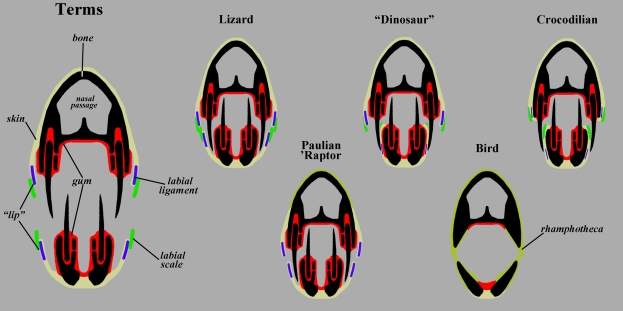
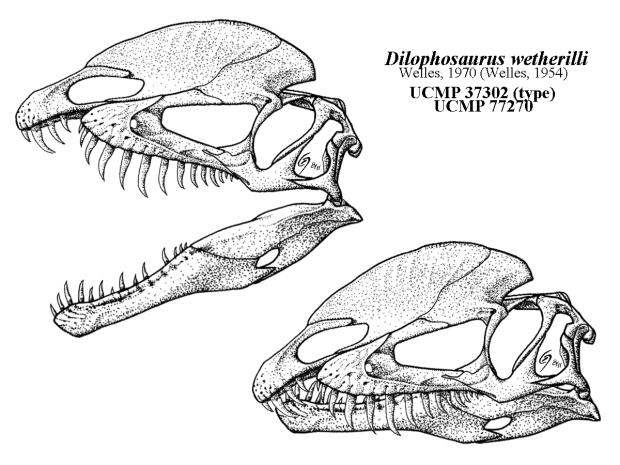
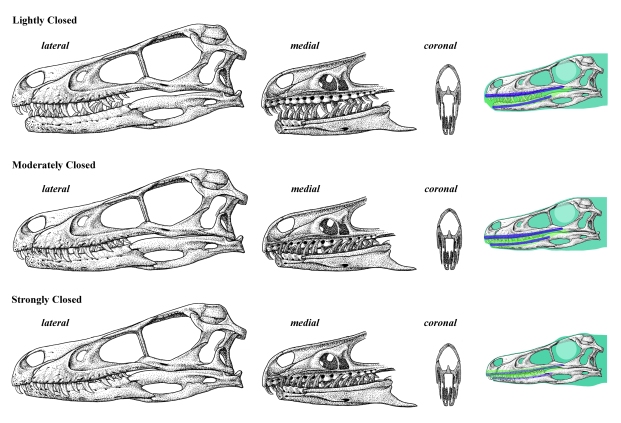
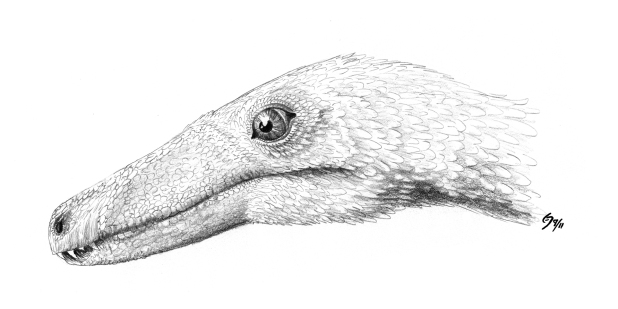


What about my work?
Tracy
I actually do not reference a lot of historical work on the subject. Most of it was based on popular media representations, which is why I included Greg’s work in the discussion. The other aspect is that I simply do not have the materials for reference on the subject, or I would have gone into deeper anatomical detail in regards to analogues. While I was aware of your discussion, I have never read it, and thus would have been unable to comment on it. For that, I apologize.
Yep, accurately restoring dinosaur it’s a rather risky business, especially in the head department… Many animals today have skulls that look NOTHING alike their heads with flesh and muscles on, heck, not even us humans!
Regarding theropods lips, well, i guess it depended on the species: some may had fleshier lips while others didn’t, maybe some had a keratinized face like a croc, while others… Aah, it doesn’t matter how you look at it, we still have no clue how they REALLY looked like!
And that’s frustrating.
I read mention of an article by Mr. Ford (Prehistoric Times) in the DML archives, but haven’t been able to find any accessible overview of the argumentation therein.
Do you know of any source where I can read up on this?
The topic is actually under works by Larry Witmer, but currently some of the best reviews on the subject actually come from Tracy (for one) and Greg Paul’s arguments for reconstruction tend to simply imply the lips are present and no commentary is given. I allude to this in the post, but the literature tends to be fairly silent about it. As I said, Tracy’s argument is the closes to discussing the thing in specific detail (but this is based on second-hand knowledge, as I’ve not read the piece). Most other arguments for or against tend to be derived from taking living animals and simply slapping them into dinosaurs, or involve discussions of the ornithischian “cheek” in which there is NO discussion of “lips” involved at all.
Pingback: drip | david’s really interesting pages…
So it turns out that a a lot of this discussion was addressed by a grad student project and presentation at SVP that isn’t published yet (she’s now working with Witmer, so I expect some excellent papers at some point).
It turns out that foramina can be quantified and show very specific correlation with extra-oral tissue types, completely contrary to comments above claiming they don’t indicate anything but sensitivity. Alas, since SVP embargos stuff it’s a W4TP sort of situation at the moment.
I don’t actually say they only indicate sensitivity, but that they are linked to innervation and in some regions of the jaw, they are linked to some organs. I write: “Lizards and crocs, just as in some birds, have some additional facial features that mammals lack, such as the presence of electrosensory organs like dermal pressure organs or Herbst corpuscles. These require additional innervation.” I am aware of the work by Witmer’s Lab, and have alluded to it both in the post and the comments.
Ashley Morhardt did her Master’s with Matt Bonnan, so referring to her SVP Abstract on neurovascular foramina patterns in archosaurs should thus be referred to as her work, or, that of Bonnan’s lab–if you insist on lumping all research that comes out of an advisor’s students as “his/her” lab’s work. As much as lab branding seems to be a chic thing (I’m guilty myself), please give credit to the actual students for their hard work and personal contributions to science rather than simply lumping them into someone’s lab. It’s not really fair to the students.
On topic-Lips, their holes, and adnexa are very interesting and worthy of rigorous pursuit along a number of fronts. Although aesthetics is the least interesting of them. As far as croc faces go, Ian George, a Mizzou IA PhD student will be presenting a poster on morphometrics of the trigeminal nerve in crocodyliforms with significance for somotosensory potential at SVP. Cool stuff. The paper will be submitted soon.
I would love to credit the authors of the individual projects works’ individually, were it presented. At the moment, I am loathe to even post abstracts, and wait for the formal work to start assigning formal authority as to whose work it whoms. I understand that true credit to the students is best, but in some cases, I do not actually know, but know the lab in question, and thus feel is safer to refer the Lab and thus proxy the fame involved.
I know the movement to “figuring out” this stuff is proceeding well apace, and look eagerly to discussing all of it. All of the labs and thus all of the students and PhDs/MDs involved in the work are providing, as much as I know, firm details on all of the little things I mention as needing knowing. As you say, cool stuff.
I’m Sorry, I didn’t mean to come off like an ass like that. This is a good post on an obviously contentious topic that still hasn’t been treated rigorously and/or published-it’s also a really challenging subject. Keep it up!
Casey, thanks!
I’m trying not to be super definitive in my remarks, largely because for many of them, it’s speculation. Even for previous published treatments (i.e., Tracy’s) there’s a problem with how far you can go. I want to know, but would rather not stick my foot in it.
I do respect the hands on work you and Larry are doing on the topic of cranial anatomy, much of which I intend to use to inform my speculations, so it’s no surprise I refer people to the works on the subject you guys have published. I’m a func-morph kinda guy.
Great article Jaime.
What about parrots and the like, who often have quite a large amount of fleshy tissue that serve a lip like function around the back of the beak…

I’m not sure how much muscular support there is for these structures or even if there’s an indication on the skeletal anatomy of their existence.
Parrots have a few extra muscles running from the jugal to the mandible, making for additional cheeky muscles and soft-tissues that would not be expected in other birds. The psittaciform-only muscle M. pseudomasseter is, in fact, named for its allusion to the mammalian M. masseter, and that’s what really sets parrots apart, also giving them extraordinarily adept strength and precision in their jaws. The skin in the image shown wraps immediately around the macaw’s mPSM, so there’s no real room for extra flaps and stuff to infer.
Thanks Jaime, good to know from my perspective as a half baked “Paleo-Artist”!
Excellent site by the way.
Condors and other vultures seem to have more fleshy tissue than parrots, their beaks being particularly short. http://www.photographyofbirds.com/images/070906093016_California_Condor_LG.jpg
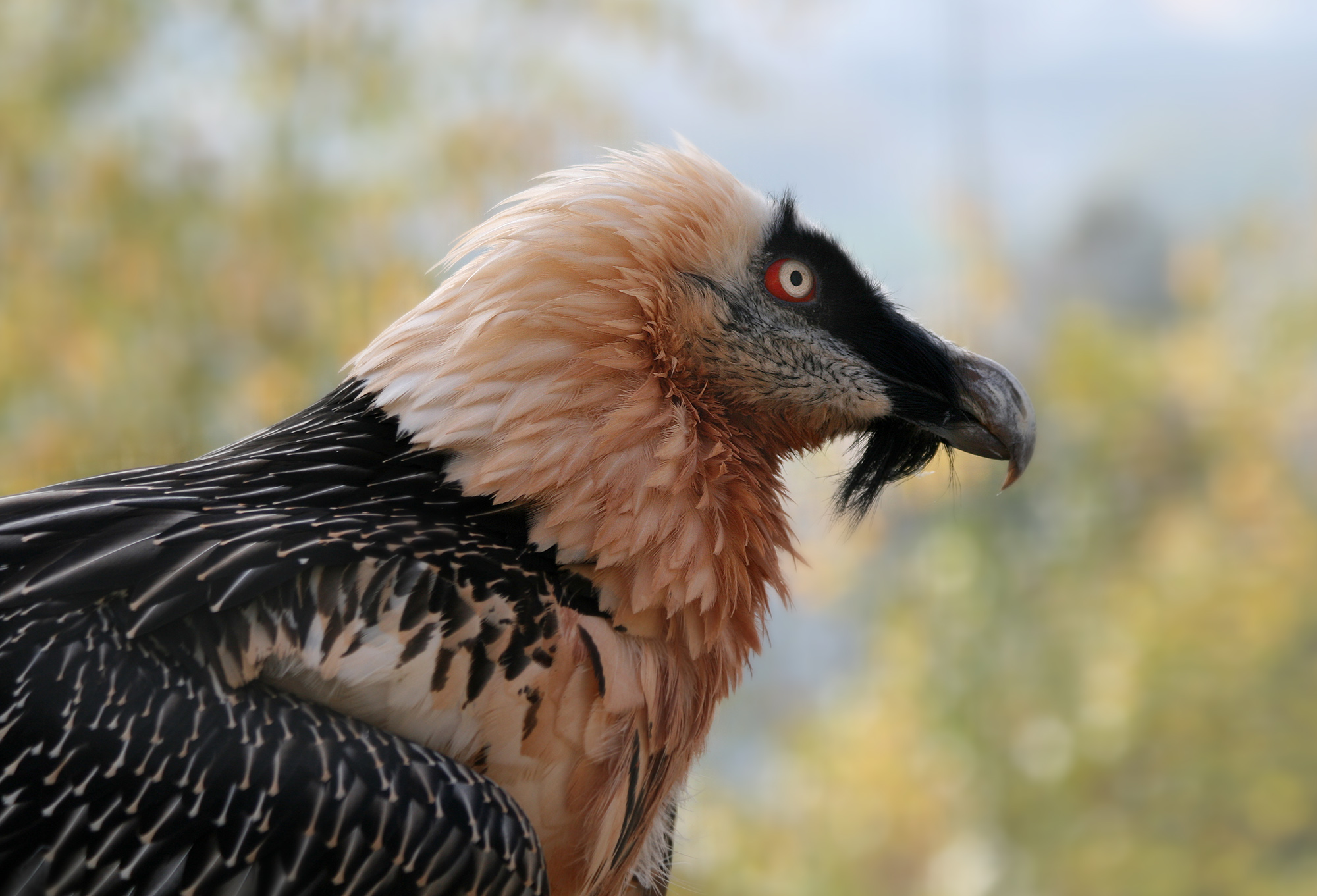
This can also be seen in the bearded vulture
Judging by the skulls of these birds the flesh seems to just tightly wrap around the jaws.
Could this be a basal feature or would it be a newer development from a more ‘beaky’ past of these birds?
It appears unique to a group of these birds. The flesh in the lammergeier at least is split between upper and lower beaks, but in the condor extends across the jaws. I am not aware of the form this flesh takes in the latter, but at least the skull appears to have a distinct margin on the bone, as in other raptors, where the beak begins and ends. The jaws do seem to be unable to close entirely behind the beaked-portion, though I haven’t investigated this, and this is based on a very cursory look at skulls, fleshed heads, and almost no literature-delving. You are correct in that the beak in these birds are very short.
From handling a few birds, I have noticed that the structure at the corners of their mouths seem to function a lot like lip remnants. I’m not sure if the structure is the same, but the tissue is actually rather extensive and despite being covered by feathering much of the time, it seems to be present in all birds I’ve handled. It is especially prominent in passerine youngsters, where the structure is often swollen, brightly coloured and stretchy. This tissue is almost always the same colour as the beak, is softest at the corner of the mouth and grows gradually firmer until it blends into the hard edges of the beak. My pigeons even have rather gummy, lippy tissue extending along the hind edges of the beak for a third of the length, which is pliable enough to squish around a little with no discomfort to the animal aside from the taste of my fingers jammed in his mouth.
Some photos that show the structure, but do not truly demonstrate the texture and nature of it.





http://cache2.asset-cache.net/gc/145679778-bird-yawning-gettyimages.jpg?v=1&c=IWSAsset&k=2&d=DzI0Clw4Xll4izAYP232pjbWyjAwY4ggRdPgvA4yjSDVnCChkseuicZ1OUoQwIIu
http://ibc.lynxeds.com/files/pictures/Great-Blue-Heron-14.jpg with this heron, the lower bill has a slightly glossy, swollen looking rim. http://ibc.lynxeds.com/files/pictures/Great-Blue-Heron-14.jpg
Other birds, it’s hard to discern whether the structure is a cheek or a lip or what. I freely admit that my anatomical knowledge is mostly practical and instinctive at the very best,
mostly just what I have gleaned from commonly available (and non expensive!) texts and a lifetime of handling animals. I am struggling to find any terminology for the corner of the mouth structure or the flexible edging near the beak, so I’m not sure if this is new or old information, and if you do know about it I would like to be enlightened.
Jade,
My understanding of this is generally to the basic: I do not have information of the per-taxon arrangement of the soft-tissues lining the mouths of most birds, merely a few, and of those it is also basic in as far as that goes: rhamphotheca, musculature, and general, superficial morphology. This allows me to say somethings, but not others. One thing ti helps we with, though, is note that birds do not really vary extensively in general morphology from one another, from condors to parrots to shorebirds or waders or ducks or whatnot. Casey Holliday points out here, as a result of the discussion this post and the followups I made spawned in some venues, about the rictal morphology of flamingos, which is large, fleshy, and very much like a “cheek,” though unlike that of the California condor and certainly unlike the “cheek” in parrots, which is mostly muscle. I am willing to wait patiently on the morphology angle to bear out, be it against my argument (that soft, nonmuscular tissues lines the sides of ornithischian jaws) as I am for studies that confirm it (that there aren’t evidences for extensive soft-tissues — at least those argued in this post and in the others — beyond the typical sauroposidan facial integument). There is no doubt that there is data for variation and the presence of large fleshy appendages in some turtles or birds, but I feel the ostoelogical data and evidence for nerve and muscle attachment can help resolve and constrain what kind and how much of it is present, so that when we look at dinosaurs, we can point to this data and say there is a reasonable level of inference to our hypotheses.
Thank you so much for reviving this topic. It is of special interest to me because of the time I spent considering foramina of the facial skeleton while studying at Western Illinois University under the direction of Dr. Matt Bonnan. Ultimately, my early work studying facial structures did indeed spur my desire to seek a place in the WitmerLab, one of the best in the country (world?) for training to become and expert in archosaur cranial anatomy.
Publication of my M.S. work continues to be a goal of mine, though I hope to enhance the quality of it as my mastery of all things anatomical continues here at Ohio University. True, I presented results at SVP Bristol that indicated a correlation between foramina count and soft-tissue type. However, the study at the time had not considered factors such as foramina density, location, and contents (i.e., vessels + nerves). You also bring up an excellent point — and should not apologize for your reconstruction images — regarding absolute and relative space allotted for soft-tissue placement along the margin of the mouth.
One humble suggestion: though I recognize that this post is informal and intended to spark discussion rather than assert definite conclusions, I would caution your use of the word “lips,” at least without quotation marks, when discussing dinosaurs. Using quotes distinguishes between true mammalian lips (underlying muscle is derived as facial muscle from the platysma m.) and “lips” or lip-like structures (e.g., marginal scales) present in other clades. Beyond that small critique, I find your observations compelling and not dissimilar to those I made when writing my thesis.
The relationship between paleobiologists/comparative anatomists and artists is a strong, important one. Scientists need artists to help bring their conclusions to life for proper and effective dissemination. Artists need scientists to clarify anatomical and functional detail, allowing for accurate reconstructions. However, the two disciplines often approach reconstruction from different perspectives (as you say, aesthetic vs. technical). Reconstruction, if done well, incorporates both. It is out of respect for the process of science and the hard work of the artists that I have held off on publishing my work. I’d rather have anxious artists tapping their watches at me (just ask Tyler Keillor eek!) than submitting a manuscript that confounds the science more than it clarifies it. In the meantime, I look forward to discussing this uber-exciting (at least to me) topic at SVP. I’ll be presenting recent work on stegosaur brain reconstruction on which Dr. Witmer, Ryan Ridgely, and I collaborated this past year.
If you, or anyone else for that matter, have questions about the conclusions I discussed at SVP 2009, I can be contacted at am159410@ohio.edu. All the best!
Ashley, thanks for replying!
Sadly, I can’t make it to SVP this year, or I’d totally find you and I can pick your brain about your work, and compare it with what I otherwise desire to learn. I will eagerly await publication on the results from the labs you, Holliday and Witmer will be able to produce on facial reconstruction.
I take you point about “lips,” especially as I attempted to use cautionary language — although without quotation marks — and in extraneous discussions on this topic elsewhere I’ve been more careful to use quotation marks. I’ve for the most part been using the term to denote the fleshy structures outside the gums, but that’s always misleading and I will make sure such confusion isn’t evident in the future.
Enjoy your talk at SVP!
How much do we know for certain about the lip structure of sabre-toothed cats? Is it possible that some or all species had Thylacosmilus-type sheaths made of cartilage?
Thylacosmilus is particularly different from modern cats, where our presumption is that as in modern forms, the extended chin this not support any extraneous structures into which teeth fit. This is fitting, because the jaw anatomy and function between the marsupial “tiger” and sabrecats is distinct, one favoring limited functionality or delicate position, and the other perhaps for display. However, flanges fitting over the teeth? Unlikely. Both groups of animals likely supported their teeth using an extended symphyseal “flange” or “chin,” but this was likely still exposed to the air. Some living cats still expose their teeth, and a close or open jaw reveals the “hanging lip.” In cats, for example this one, there is even a sort of “pocket” for insertion of the tips of the upper canines. In most dirk-toothed sabretooths, the upper canines protrude below the margin of the jaw, and this prevents any sort of neat, protective covering, while shorter sabre-toothed cats and the cookie-cutter cat Xenosmilus the teeth are shorter than the chin, and may have been mostly protected and partially visible.
Pingback: Sideshow Collectibles Apatosaurus Maquette, Part 2: the head « Sauropod Vertebra Picture of the Week
Hi,
very interesting post! I am by no means an expert on any of the subjects here, I’d just like to point out that the teeth and jaws of crocodiles seem to represent a highly adapted rather than a basal form (see wikipedia). I dont know much about the skull shapes of the ancestors of the crocodiles but they seem to be very diverse as some even evolved to herbivory lifestyles. There are also interesting cases of convergent evolution with respect to crocodilian jaws like Spinosaurus and Mosasaurus. Based on this they may be of limited value to draw inferences on theropod lips…
Hi Florian! Thank you for replying.
The reason modern crocodilians are relevant as much as they are is that they are the only other living reptilians for which any form of non-rhamphothecal jaw tissue is available: It is either birds, turtles, lizards, snakes, or crocs. Taking what we know of their common ancestors we can certainly infer that the “lip” structures in ancestral crurotarsans were lizard-like, but have only the modern morphologies to draw upon now. This is all of course relevant only so far as the soft-tissue correlates are known for the underlying bone tissues and dentition placement and morphologies of both, which is currently the subject of some researchers’ pre- and post-Doctoral work (for example, Ashley Morhardt, who also responded in this thread). Hopefully we will learn more details about what exact morphologies can be inferred when we only have bone tissues to go upon.
As it is, data suggests that a rugose surface with large foramina is likely related to closely-adhering dermis, rather than open, more lose “lip” like structures. How close, or how loose, is a matter to be determined.
Dear Jaime,
thank you for clarifying. This is such an exciting field of study with new groundbreaking discoveries every other month. I really appreciate you making this more accessible to people that aren’t involved in the scientific discussions themselves! Thank you Jaime!
Pingback: A Skull Reconstruction for Daemonosaurus | The Bite Stuff
Pingback: A Look Back at the Bite Stuff, 2013 Edition | The Bite Stuff
Pingback: Something About Overbites | The Bite Stuff
Pingback: The Emaciated Tyrannosaur – a Reply to Ford, 1997 | The Bite Stuff
Pingback: Speculative Evolution: Masticating Waterfowl | Gwawinapterus
Pingback: Velociraptor reconstruction | Oliver Demuth
Pingback: Facial Expressions | The Bite Stuff
Pingback: 10 cosas que NO se le deben hacer a un T. rex | mi sitio
Pingback: 10 cosas que NO se le deben hacer a un T. rex | My Blog
hi,

your blog page has been altered by some link erosion, here is where I found the Komodo dragon:
Thanks for your passion, that matters!
Pingback: Tyrannosaurus Redesign 2018 - Tops from the world
Pingback: Chubby and naked: meet the most accurate T. rex reconstruction to date - Science Nuclear
Pingback: Chubby and naked: meet the most accurate T. rex reconstruction to date - Science News
Pingback: Chubby and naked: meet the most accurate T. rex reconstruction to date - Science Daily Press
Pingback: Chubby And Naked: Meet The Most Accurate T. Rex Reconstruction to Date – Techsemut English
Pingback: Chubby and naked: meet the most accurate T. rex reconstruction to date - Science News Mag
Pingback: Meet The Most Accurate T. Rex Reconstruction to Date - Science News
Pingback: Meet The Most Accurate T. Rex Reconstruction to Date - Science Level
Pingback: Meet The Most Accurate T. Rex Reconstruction to Date - LiveBrain.com
Pingback: Meet The Most Accurate T. Rex Reconstruction to Date - Science Informers
Pingback: Meet The Most Accurate T. Rex Reconstruction to Date - Science Alarm
Pingback: Meet The Most Accurate T. Rex Reconstruction to Date - Science Finest
Pingback: Meet The Most Accurate T. Rex Reconstruction to Date - New Now Science
Pingback: Meet The Most Accurate T. Rex Reconstruction to Date | Science News Magazines
Pingback: Meet The Most Accurate T. Rex Reconstruction to Date - Science News Hub
Pingback: Meet The Most Accurate T. Rex Reconstruction to Date - Science Global News
Pingback: Meet The Most Accurate T. Rex Reconstruction to Date ⋆ Discovery
Pingback: Chubby and naked: meet the most accurate T. rex reconstruction to date - Weird Facts About Life
Pingback: Animal Eagle
Pingback: Did T. rex Have Lips? | Best of the Internets